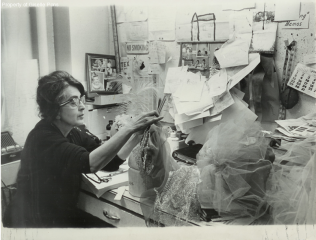1920-1921 Helene arrived in Paris with very little money. She lodged in a squalid room above a factory and supported herself painting ceramics. She desperately wanted to bring her mother, Barbara, to France and sent money to Tiflis, Instead, it was her younger sister Barbara who joined her. In the evenings the two sisters would go to Montparnasse where she met Modigliani and Diego Rivera. They were befriended by the ex-wife of film director Abel Gance, who offered to rent a room to the girls.
1921 Helene met George Pons, son of a French officer who taught fencing at the court of the czar. George had received his master in romance philology at the University of Moscow and was happily working at the Moscow Art Theatre under Konstantin Stanislavsky when, because of Stalin’s new xenophobic laws, he was suddenly ordered to leave the country within 24 hours. George passed the Finnish border at Terrioké (a curious coincidence: this was the setting for HP’s book The Story of Vanya) and came to Paris to work as technical director for Nikita Balieff’s Chauve Souris vaudeville company which was successfully performing at the Théatre Femina. At the end of summer George went on tour to England with the company leaving Helene in Paris. In London, after an uncertain début at the enormous Pavillion Theatre, the company moved to the more congenial Apollo where Balieff’s cordial give-and-take with the audience in broken English was more effective. The reviews were enthusiastic: “Altogether it was a rich and riotous evening – far funnier than could have been imagined, with many touches none the less of true and tender art.” George had great difficulty in obtaining an English entry permit for Helene because she bore an Armenian passport which England did not recognize. Thanks to the intervention of a friend who worked for the US State Department, Helene finally arrived in London where she married George and was immediately put to work by Balieff making dolls designed by Sergei Soudeikine for the Chauve Souris.
1922 January 31st : arrival in New York on. Lapland from Southampton with the Chauve Souris company. Their NY debut on February 5th is acclaimed by the enthusiastic critics who compliment impresarios Ray Comstock and Morris Gest for bringing the ‘Bat Theatre’ to America. True to its repertory tradition, the Chauve Souris closes after 65 performances at the 49th Street Theatre and moves to the more congenial Century Roof Theatre on 62nd Street and Central Park West. The theatre is completely redecorated in Russian style. A new even more successful program is presented on June 5th and runs through the summer until October. September 3rd entire company is taken on private train to Southampton L.I. for the benefit of the Rogers Memorial Library sponsored by members of the local high society. Every three months the company renews its program.
1923 After a last performance on May 5th, the Chauve Souris company sails for France on the Mauretania on May 8th for a working holiday playing again at the Théatre Fémina in Paris starting May 24th. Expat Americans flock to the show and implore Balieff to return to the US.
George and Helene return to the United States with the company on the new French liner Paris on August 11th. The new Chauve Souris production opens at the Century Roof Theatre, completely restyled à la Russe on September 3rd .
1926-7 George leaves Chauve Souris and the Pons family begins to make costumes designed by Henry Dreyfuss for the stage shows at the Mark Strand theatre in their two-room apartment on the upper West Side..
1928 Helene Pons Studio is established. Helene and George are now creating costumes for the most prestigious Broadway shows. George brings the techniques of the Moscow Art Theatre costume laboratory to New York and Helene at first is a timid apprentice, but little by little – thanks to her inordinate talent, will power and personal charm – she assumes the dominant role in the business. (See list of plays she either designed or created the costumes for.)

